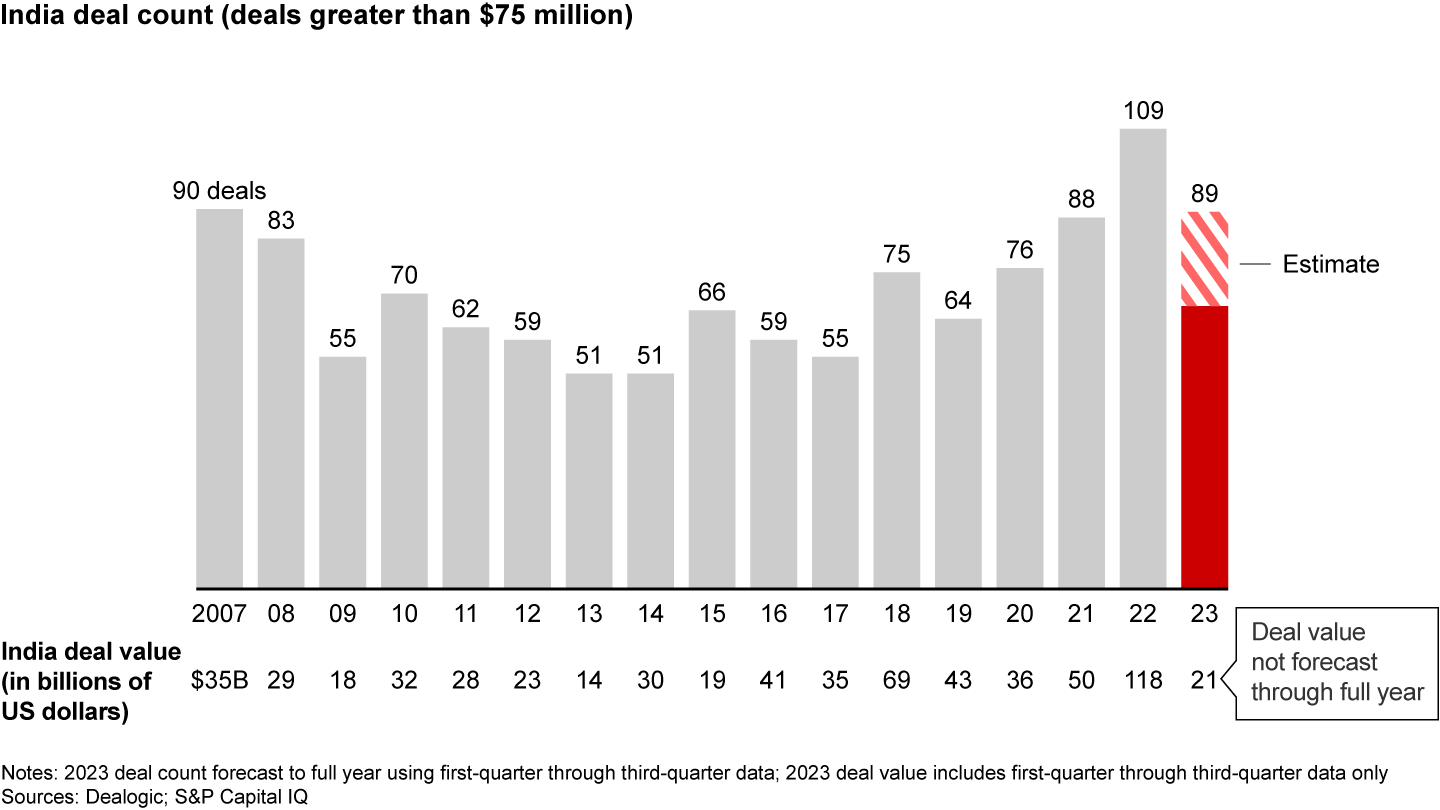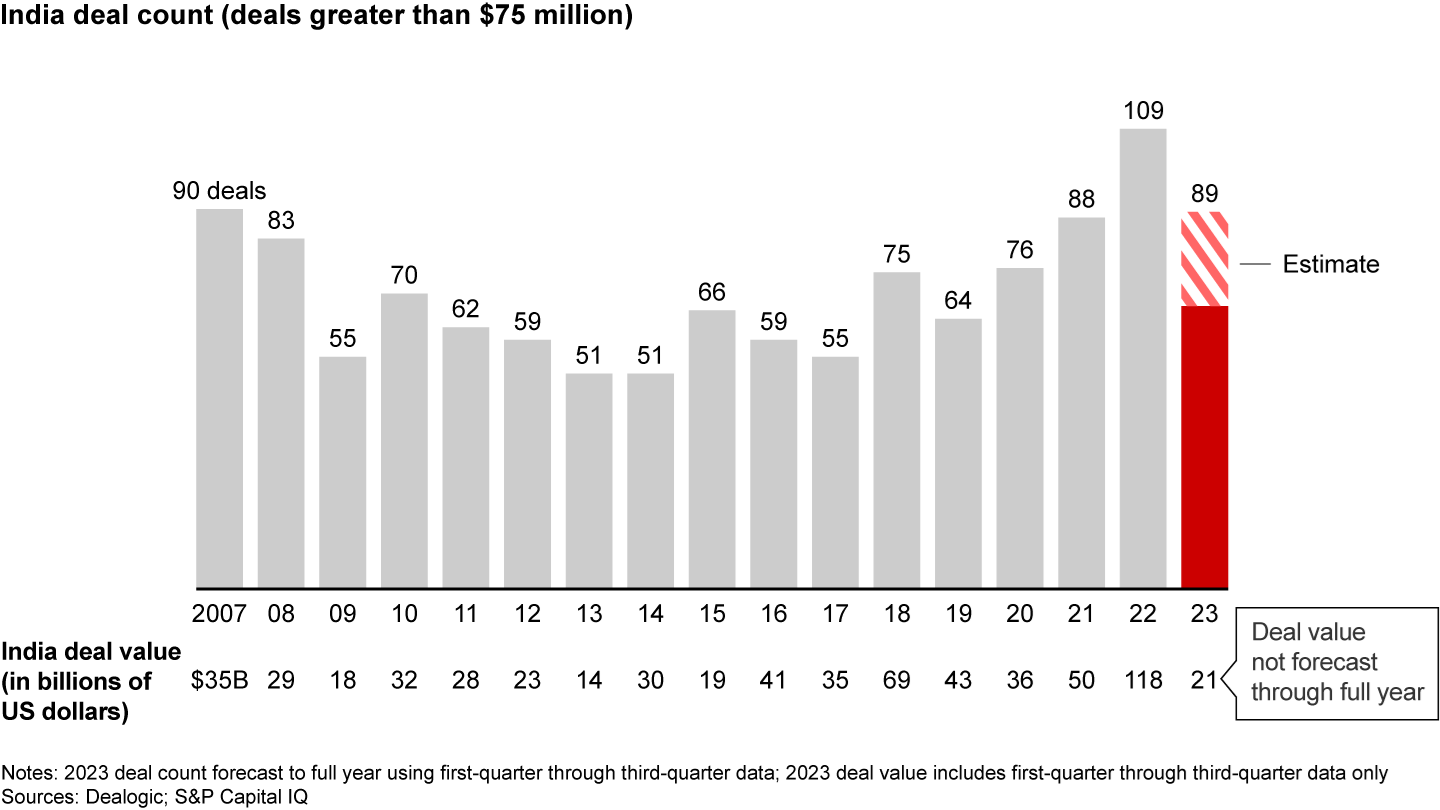M&A Report

한눈에 보기
- After a record 2022, the M&A market in India maintained its long-term momentum in 2023.
- Midmarket acquirers were active, along with conglomerate M&A, Engine 2 acquisitions, and balance sheet restructuring.
- Market sentiment is bullish, with most dealmakers expecting a continuation or an improvement during 2024.
- Buyers are engaging in more sophisticated pre-deal diligence and more detailed post-deal planning.
This article is part of Bain's 2024 M&A Report.
While much of the globe’s developed economies are in the doldrums, fast-growing India continues to speed ahead, with its annual growth forecast at 6% to 7% vs. 2% or less for developed markets.
This is reflected in India’s M&A activity. While deals slowed down following a boom year in 2022, activity in 2023 remained robust, with volume estimated to be above levels seen over the past 10 years, excluding 2022 (see Figure 1). An increase in the relative share of deals in sectors with a structural growth outlook and favorable policies toward renewable energy, infrastructure, logistics, and manufacturing accounted for one in every three deals over the past 18 months. Healthcare also emerged stronger, with deal volumes growing consistently over the past five years, the result of quality assets coming to market and a positive sector outlook.


More than 80% of respondents to our annual M&A Practitioners’ Outlook Survey from India expect to close a similar number of deals or more in 2024. They also expect the availability of attractive assets to increase. M&A practitioners in India are not stymied by many of the headwinds that stall deals in other markets—they’re less concerned about cost of capital, for example.
The steady activity and increased appetite for M&A means more competition for deals and sustained valuation across sectors. But are the midmarket and conglomerate buyers that make up an increasing share of M&A activity in India up to the task of winning the deals that will help them scale their businesses or find new sources of growth amid intensified competition?
Deals by midmarket acquirers (up to $1 billion in revenue) accounted for almost 50% of India’s M&A activity. Scale M&A helps these companies supplement organic growth to build industry leadership positions over time. For example, mattress maker Sheela Foam announced its move to acquire rival Kurlon, and Ipca Laboratories made a bid for a controlling stake in pharmaceutical peer Unichem.
Torrent Pharmaceuticals illustrates how this strategy can play out over years. It completed a series of acquisitions that have grown in size and ambition, starting with Elder in 2013, followed by Unichem’s domestic business in 2017, and most recently the $245 million deal for Curatio. The acquired brands have helped Torrent bolster its branded generics portfolio as well as build a high-value consumer health portfolio. Today, Torrent is one of the leading pharma companies in India, with demonstrated appetite for more M&A.
Meanwhile, conglomerates are actively pursuing Engine 2 opportunities to create new lines of growth. For example, Reliance Retail continued its long-running acquisition drive in 2023, building omnichannel retail scale with its purchases of Raskik, V Retail, and Ed-a-Mamma. Aditya Birla Group’s acquisitive house of brands business, TMRW, made its ninth acquisition in 2023 with menswear brand TIGC, adding to its eight digital-first lifestyle brands already acquired. Industry leaders are also branching out into new growth areas. For example, PI Industries, a leading agrisciences company, forayed into pharma with two global acquisitions.
Other large companies reshaped portfolios and strengthened balance sheets via divestitures and spin-offs. Noncore disposals included deals such as SpiceJet hiving off SpiceXpress, its cargo and logistics business, and Dalmia Cement offloading its refractory business via a share-swap agreement to focus on cement production in late 2022. Raymond Consumer Care has transformed its portfolio by divesting its fast-moving consumer goods business. First, it sold its leading brands in deodorants and sexual wellness categories to Godrej Consumer Products; then, it de-merged its lifestyle business to create a separate listed entity.
As midmarket and conglomerate buyers prepare for increased competition, they need to more rigorously assess their diligence capabilities and their potential for post-deal value creation. High-quality due diligence is always a critical factor that contributes to deals outperforming expectations. With more competition in the mix, the surest way to succeed is to come armed with proprietary insights from diligence that are deeper and more focused than that of competitors.
Midmarket acquirers building out scale positions seek to amplify top-line growth and profitability. Therefore, due diligence should investigate the target’s customer positioning and operational performance for sources of revenue and cost synergies. Conglomerates contemplating an Engine 2 platform acquisition will have a broader diligence agenda. They need to test not only the underlying commercial dynamics but also identify the critical talent and capabilities unique to the assets and how those will best create value under new ownership. They might test potential new value propositions with customers via primary research or use third-party data to get an outside-in view on the target’s talent and culture.
A leading life sciences company did extensive primary research with consumers, doctors, and chemists both in the field and by analyzing online consumer reviews to assess the full potential value for the target’s brands. The research uncovered an unanticipated opportunity to accelerate the growth of select brands in the portfolio. That opportunity became part of the deal thesis, and it has resulted in additional value creation post acquisition.
In another example, an acquirer evaluating a target in the wearables ecosystem decided to dig deeper into the target’s supply chain, which was a key to the potential acquisition’s market leadership. While conducting interviews with suppliers and market participants, it was discovered that an early advantage that the target had in product design and supplier relationships was not sustainable.
As always, a great diligence also plans for successful integration. A midmarket company doing a scale deal may need to balance quick operational integration with longer-term initiatives to support revenue growth. For example, when a leading Indian consumer products company acquired a global competitor’s India business, it moved quickly to begin integrating non-customer–facing functions, but it intentionally kept the two sales teams separate for six months to ensure that there was no frontline disruption during a peak season. In deals that are focused on capabilities, a different approach may be required—maintaining an acquisition as a standalone business run by its founders, for example.
As more assets become available and competition heats up in India, disciplined diligence can provide the edge to win the deal, creating value for midmarket buyers and conglomerates alike.